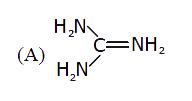The strongest base among the following is




The correct Answer is:A
To determine the strongest base among the given options, we need to analyze the basicity of each compound based on the presence of lone pairs and the electronegativity of the atoms involved. Here’s a step-by-step solution:
Step 1: Identify the Compounds
First, we need to identify the compounds given in the question. Although the specific compounds are not mentioned in the transcript, we will assume they are nitrogen or oxygen-containing compounds based on the context.
Step 2: Understand Basicity
Basicity refers to the ability of a compound to accept protons (H⁺ ions). A stronger base has a higher tendency to accept protons. This ability is often related to the presence of lone pairs of electrons on the atom that can bond with the proton.
Step 3: Analyze Electronegativity
Electronegativity plays a crucial role in determining basicity. The less electronegative an atom is, the more likely it is to donate its lone pair to bond with H⁺. For example, nitrogen (N) is less electronegative than oxygen (O), which means nitrogen is generally a stronger base than oxygen.
Step 4: Count the Lone Pairs
Next, we need to count the number of lone pairs on the nitrogen and oxygen atoms in each compound:
- If a compound has more lone pairs on nitrogen, it will be a stronger base.
- If a compound has lone pairs on oxygen, it will be less basic due to oxygen's higher electronegativity.
Step 5: Compare the Compounds
From the analysis:
- If one compound has three nitrogen atoms with lone pairs and another has two, the one with three nitrogen atoms will be more basic.
- If both have the same number of nitrogen atoms, we need to consider the stability of the resulting conjugate acid after protonation.
Step 6: Determine the Strongest Base
Based on the analysis, the compound with the most favorable conditions for accepting protons (i.e., more lone pairs on less electronegative atoms) will be the strongest base. In this case, the compound with three nitrogen atoms and more lone pairs is identified as the strongest base.
Conclusion
Thus, the strongest base among the given options is the one with the most nitrogen atoms and lone pairs.
---
First, we need to identify the compounds given in the question. Although the specific compounds are not mentioned in the transcript, we will assume they are nitrogen or oxygen-containing compounds based on the context.
Basicity refers to the ability of a compound to accept protons (H⁺ ions). A stronger base has a higher tendency to accept protons. This ability is often related to the presence of lone pairs of electrons on the atom that can bond with the proton.
Electronegativity plays a crucial role in determining basicity. The less electronegative an atom is, the more likely it is to donate its lone pair to bond with H⁺. For example, nitrogen (N) is less electronegative than oxygen (O), which means nitrogen is generally a stronger base than oxygen.
Next, we need to count the number of lone pairs on the nitrogen and oxygen atoms in each compound:
- If a compound has more lone pairs on nitrogen, it will be a stronger base.
- If a compound has lone pairs on oxygen, it will be less basic due to oxygen's higher electronegativity.
From the analysis:
- If one compound has three nitrogen atoms with lone pairs and another has two, the one with three nitrogen atoms will be more basic.
- If both have the same number of nitrogen atoms, we need to consider the stability of the resulting conjugate acid after protonation.
Based on the analysis, the compound with the most favorable conditions for accepting protons (i.e., more lone pairs on less electronegative atoms) will be the strongest base. In this case, the compound with three nitrogen atoms and more lone pairs is identified as the strongest base.
Thus, the strongest base among the given options is the one with the most nitrogen atoms and lone pairs.
Topper's Solved these Questions
- CARBOXYLIC ACIDBOOK - MOTIONCHAPTER - CARBOXYLIC ACIDEXERCISE - Exercise - 3
16 Videos
- CARBOXYLIC ACIDBOOK - MOTIONCHAPTER - CARBOXYLIC ACIDEXERCISE - Exercise - 4 (LEVEL - 1 )
15 Videos
- CARBOXYLIC ACIDBOOK - MOTIONCHAPTER - CARBOXYLIC ACIDEXERCISE - Exercise - 2(LEVEL - 1)
26 Videos
- CARBONL COMPOUNDSBOOK - MOTIONCHAPTER - CARBONL COMPOUNDSEXERCISE - EXERCISE - 4 LEVEL -II
24 Videos
- CHEMICAL BONDING BOOK - MOTIONCHAPTER - CHEMICAL BONDING EXERCISE - EXERCISE -4 LEVEL-II
40 Videos
Similar Questions
Knowledge Check
The strongest base among the following will be
ALiOHBNaOHCKOHDRbOH.The strongest base among the following agent.
A2, 4, 6-Trinitro-N, N-dimethylanilineBAnilineC2, 4, 6-TrinitroanilineDN, N-Dimethylaniline.Which is the strongest base among the following ?
ALa(OH)3BLu(OH)3CCe(OH)3DYb(OH)3
